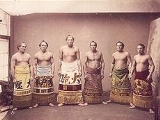
Onigatani Saiji
Encyclopedia
Onigatani Saiji was a Japan
ese sumo
wrestler who is known for being active in the top makuuchi
division at the age of 51, which is a record after the beginning of the Meiji era.
in Osaka
sumo but was recruited by former yokozuna Umegatani I
and moved to Ikazuchi stable in Tokyo
sumo. From January 1887, he recorded 20-years' career in makuuchi. He had been the oldest active wrestler in makuuchi since January 1897 when he was 41 years old. He retired in January 1907 when he was 51 years old. He was specially awarded a silver cup by the Sumo Association. He also trained future yokozuna Umegatani II
.
*tournament actually held one month later than listed.
Japan
Japan is an island nation in East Asia. Located in the Pacific Ocean, it lies to the east of the Sea of Japan, China, North Korea, South Korea and Russia, stretching from the Sea of Okhotsk in the north to the East China Sea and Taiwan in the south...
ese sumo
Sumo
is a competitive full-contact sport where a wrestler attempts to force another wrestler out of a circular ring or to touch the ground with anything other than the soles of the feet. The sport originated in Japan, the only country where it is practiced professionally...
wrestler who is known for being active in the top makuuchi
Makuuchi
or is the top division of professional sumo. Its size is fixed at 42 wrestlers , ordered into five ranks according to their ability as defined by their performance in previous tournaments....
division at the age of 51, which is a record after the beginning of the Meiji era.
Career
At first, he joined Tokitsukaze stableTokitsukaze stable
The is a stable of sumo wrestlers, one of the Tokitsukaze group of stables. It was originally founded in 1769 and was dominant during the Taishō period. In its modern form it dates from 1941 when it was established by Futabayama, who was still an active wrestler at the time. Initially known as...
in Osaka
Osaka
is a city in the Kansai region of Japan's main island of Honshu, a designated city under the Local Autonomy Law, the capital city of Osaka Prefecture and also the biggest part of Keihanshin area, which is represented by three major cities of Japan, Kyoto, Osaka and Kobe...
sumo but was recruited by former yokozuna Umegatani I
Umegatani Totaro I
Umegatani Tōtarō was a sumo wrestler from Asakura, Fukuoka Prefecture, Japan. He was the sport's 15th Yokozuna. He was generally regarded as the strongest wrestler to emerge since the era of Tanikaze and Raiden.-Career:...
and moved to Ikazuchi stable in Tokyo
Tokyo
, ; officially , is one of the 47 prefectures of Japan. Tokyo is the capital of Japan, the center of the Greater Tokyo Area, and the largest metropolitan area of Japan. It is the seat of the Japanese government and the Imperial Palace, and the home of the Japanese Imperial Family...
sumo. From January 1887, he recorded 20-years' career in makuuchi. He had been the oldest active wrestler in makuuchi since January 1897 when he was 41 years old. He retired in January 1907 when he was 51 years old. He was specially awarded a silver cup by the Sumo Association. He also trained future yokozuna Umegatani II
Umegatani Totaro II
Umegatani Tōtarō II was a sumo wrestler from Toyama City, Toyama Prefecture, Japan. He was the sport's 20th Yokozuna. Umegatani had a great rivalry with yokozuna Hitachiyama Taniemon...
.
Top division record
| January | May | |
|---|---|---|
| 1887 | Sat out | East Maegashira #8 (5-4-1) |
| 1888 | East Maegashira #4 (5-3-1-1hold) | East Maegashira #2 (3-4-3) |
| 1889 | East Maegashira #5 (3-4-2-1draw) | East Maegashira #4 (3-4-1-2holds) |
| 1890 | East Maegashira #3 (3-0-7) | West Maegashira #1 (4-3-1-1draw-1hold) |
| 1891 | West Maegashira #1 (4-5-1) | West Komusubi (5-3-1-1draw) |
| 1892 | West Komusubi (1-1-8) | West Maegashira #2 (0-2-7-1draw)* |
| 1893 | Sat out | West Maegashira #5 (3-6-1) |
| 1894 | West Maegashira #7 (2-4-1-2draws-1hold) | West Maegashira #10 (2-1-2-4draws-1hold) |
| 1895 | West Maegashira #8 (0-3-6-1draw) | West Maegashira #12 (5-0-4-1draw)* |
| 1896 | West Maegashira #4 (2-2-4-2draws) | West Maegashira #3 (2-7-1) |
| 1897 | West Maegashira #7 (1-1-7-1hold) | West Maegashira #10 (3-2-4-1draw) |
| 1898 | West Maegashira #7 (6-3-1) | East Maegashira #2 (2-2-6) |
| 1899 | West Maegashira #2 (1-8-1) | West Maegashira #4 (5-3-1-1draw) |
| 1900 | West Maegashira #3 (2-0-8) | West Maegashira #4 (4-3-1-1draw-1hold) |
| 1901 | East Maegashira #3 (2-6-1-1draws) | West Maegashira #6 (3-6-1) |
| 1902 | East Maegashira #8 (2-4-2-2draws) | East Maegashira #8 (5-2-1-1draw-1hold) |
| 1903 | East Maegashira #1 (0-1-9) | East Maegashira #5 (2-4-1-3draws) |
| 1904 | East Maegashira #10 (6-0-2-2holds) | Sat out |
| 1905 | East Maegashira #5 (3-5-1-1draw) | East Maegashira #7 (2-4-1-2draws-1hold) |
| 1906 | East Maegashira #9 (3-6-1) | East Maegashira #11 (1-3-5-1draw) |
| 1907 | retired | x |
*tournament actually held one month later than listed.
- The wrestler's East/West designation, rank, and win/loss record are listed for each tournament.
- A third figure in win-loss records represents matches sat-out during the tournament (usually due to injury)
- an X signifies the wrestler had yet to reach the top division at that point in his career or a tournament after he retired
See also
- Glossary of sumo termsGlossary of sumo termsThe following words are terms used in sumo wrestling in Japan. azukari : Hold. A kind of draw. After a mono-ii, the gyōji or the shimpan "holds" the result if it was too close to call...
- List of past sumo wrestlers

